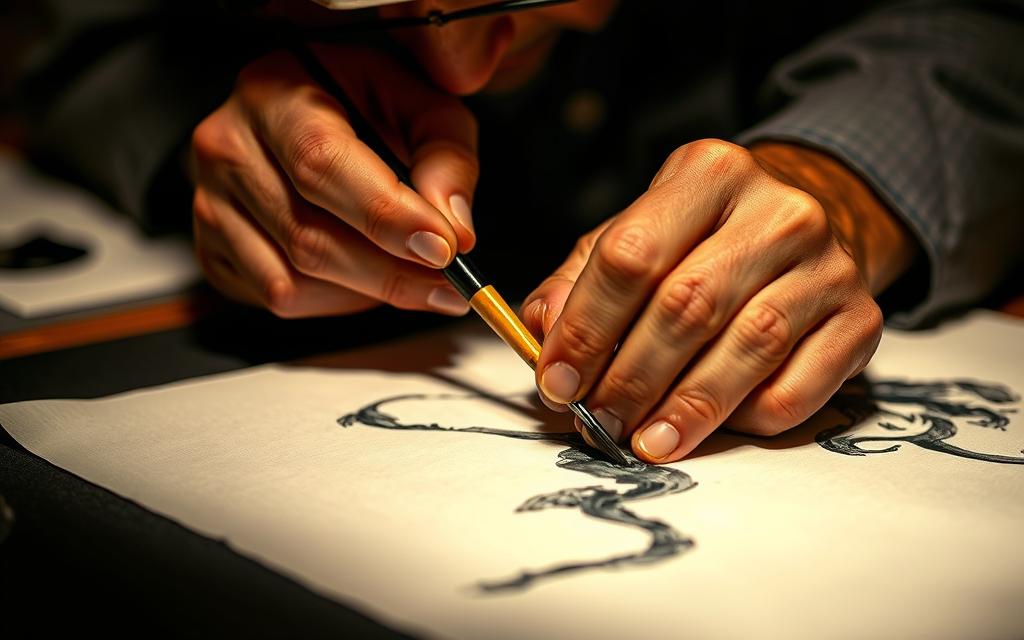Table of Contents
For over three decades, Nintendo fans have admired the stunning visuals in legendary franchises like The Legend of Zelda and Super Mario. Much of this iconic imagery traces back to one artist’s unique creative approach.
Yusuke Nakano, a veteran illustrator at Nintendo, has shaped gaming history with his hand-drawn concepts. His work appears in classics such as Twilight Princess and the massive Super Smash Bros. Ultimate mural. But how does he bring these worlds to life?
This exploration dives into Nakano’s workflow, examining whether digital tools play a role in his craft. Through interviews and references like Hyrule Historia, we’ll uncover the blend of traditional and modern techniques behind his creations.
Understanding this process matters to artists and gamers alike. It reveals how Nintendo’s signature style evolves while staying true to its roots.
Who Is Yusuke Nakano? Nintendo’s Legendary Illustrator
Few artists have left a mark on gaming as deeply as Yusuke Nakano. Born in Hokkaido in 1969, he joined Nintendo in 1992, starting with packaging design for Wario Land. His journey from crafting box art to defining entire worlds showcases his versatility.
From Hokkaido to Nintendo: A Career Spanning Decades
Nakano’s early work included item and UI art for Super Metroid (1994) and Mario 64 (1996). By 1998, he contributed to Ocarina of Time, blending 2D sketches with 3D transitions. His role evolved into a bridge between Yoshitaka Amano’s concepts and final 3D models.
“Nakano’s sketches for Twilight Princess redefined Link’s visual identity, merging realism with fantasy.”
Iconic Contributions to Zelda and Mario Franchises
Nakano’s fingerprints are across Nintendo’s biggest titles. He led character design for Twilight Princess and crafted murals for Super Smash Bros. Ultimate. His dual expertise shines in both 2D (Spirit Tracks) and 3D (Galaxy 2) Super Mario games.
| Game | Role | Year |
|---|---|---|
| Twilight Princess | Lead Character Designer | 2006 |
| Ocarina of Time | Concept Art | 1998 |
| Super Mario Galaxy 2 | Illustration Supervisor | 2010 |
His crowning achievement? Creative control over Twilight Princess, where he unified the Legend Zelda aesthetic. From Midna’s haunting design to Link’s weathered look, Nakano’s vision became synonymous with the series.
Yusuke Nakano’s Artistic Process: Traditional or Digital?
Nintendo’s signature style balances hand-drawn sketches with modern finishing touches. For Nakano, the design journey often starts on paper, where rough concepts take shape. Later stages may involve digital tools to refine textures or scale compositions.

The Tools Behind the Magic
Physical sketchbooks remain central to Nakano’s process. Hyrule Historia reveals layers of pencil strokes in Twilight Princess drafts. However, projects like the Super Smash Bros. Ultimate mural required digital brushes to mimic oil-paint textures.
This hybrid approach ensures precision without losing organic charm. Characters like Midna retain hand-crafted details, even when finalized digitally.
Standing Apart from Peers
Unlike Yoshitaka Amano’s watercolor-heavy artwork, Nakano favors clean lines and bold silhouettes. His creation of the Fused Shadow in Twilight Princess echoes Majora’s Mask’s tribal motifs, yet feels distinctly modern.
Compared to Capcom’s Street Fighter team, Nakano simplifies third-party characters into cohesive Nintendo aesthetics. The result? A unified visual language across franchises.
Case Study: The Handcrafted Magic of Twilight Princess
The creation of *Twilight Princess* stands as a masterclass in visual storytelling. Nakano’s work on this Legend Zelda title redefined how characters and environments interact. Every detail, from Midna’s piercing gaze to the Twilight Realm’s eerie glow, reflects a blend of tradition and innovation.
Midna’s Design Evolution in Hyrule Historia
*Hyrule Historia* unveils 37 concept variations of Midna, tracing her journey from vengeful imp to regal ruler. Nakano’s design process emphasized her emotional arc—orange hair pops against the realm’s muted palette, symbolizing defiance.
“Midna’s final form merges Twili elegance with her feral origins, a balance of power and vulnerability.”
Zant’s usurpation narrative shaped her visual progression. Early sketches show jagged edges, later softened into flowing robes as she reclaims her throne.
How Majora’s Mask Influenced Nakano’s Approach
The Twili race’s light-blue patterns on gray skin echo *Majora’s Mask*’s tribal motifs. Nakano reused this design language for the Fused Shadow, its eye-like markings mirroring the iconic mask.
This connection grounds *Twilight Princess* in *Legend Zelda* history while feeling fresh. Even the 66-character mural in *Super Smash Bros. Ultimate* follows this philosophy—simplifying forms without losing identity.
Conclusion: The Timeless Appeal of Nakano’s Artistry
The blend of traditional and digital techniques defines Nakano’s lasting impact on gaming visuals. His hybrid process—sketching by hand, refining digitally—ensures each piece feels organic yet polished.
Fans at Nintendo Live hailed his *Super Smash Bros. Ultimate* mural as a “masterpiece,” praising its interactive exhibit. The *Legend Zelda* and *Super Mario* games showcase his ability to evolve while honoring roots.
Even in a 3D-dominated era, Nakano’s hand-drawn methods remain vital. Future projects will likely uphold this philosophy, proving timeless art transcends tools.
FAQ
What medium does Yusuke Nakano primarily use for his artwork?
While Nakano has worked with both traditional and digital tools, his most recognized contributions to Nintendo titles like The Legend of Zelda and Super Mario often blend hand-drawn sketches with digital refinement.
How has Nakano’s style evolved over his career?
From early projects like Ocarina of Time to later works such as Twilight Princess, his designs shifted toward more intricate, atmospheric forms while retaining a distinct Japanese illustrative charm.
What role did Nakano play in the creation of Hyrule Historia?
He contributed key concept art and design insights, particularly for Midna and other characters, showcasing his deep involvement in the Zelda series’ visual development.
How does Nakano’s process compare to other Nintendo artists?
Unlike some contemporaries who rely heavily on 3D modeling, Nakano often starts with hand-drawn concepts, emphasizing organic shapes and dynamic expressions before transitioning to digital formats for polish.
Which of Nakano’s works are considered most influential?
His designs for Majora’s Mask and Twilight Princess remain standout examples of his ability to merge whimsy with darker, more complex themes, influencing later game art direction.









